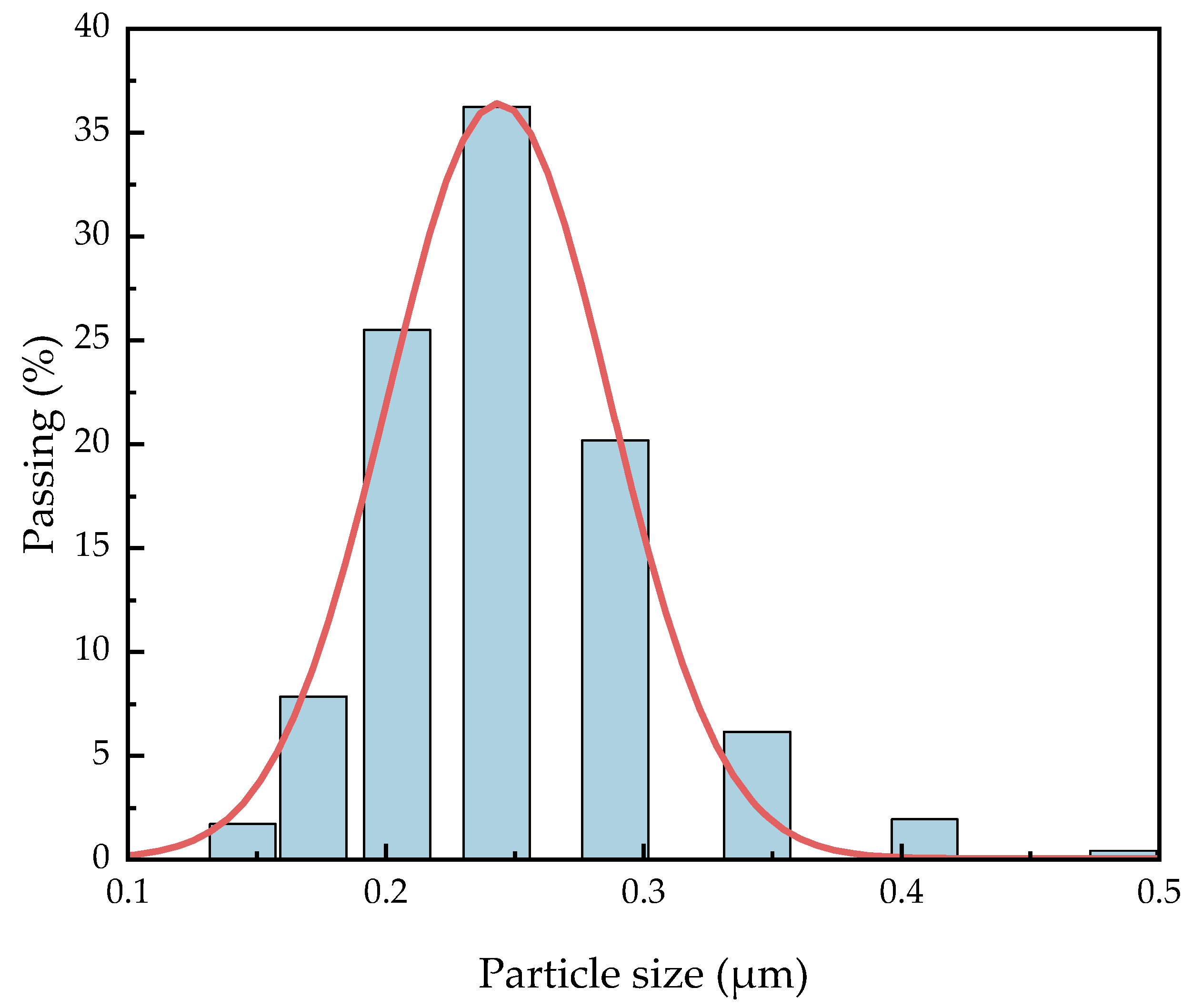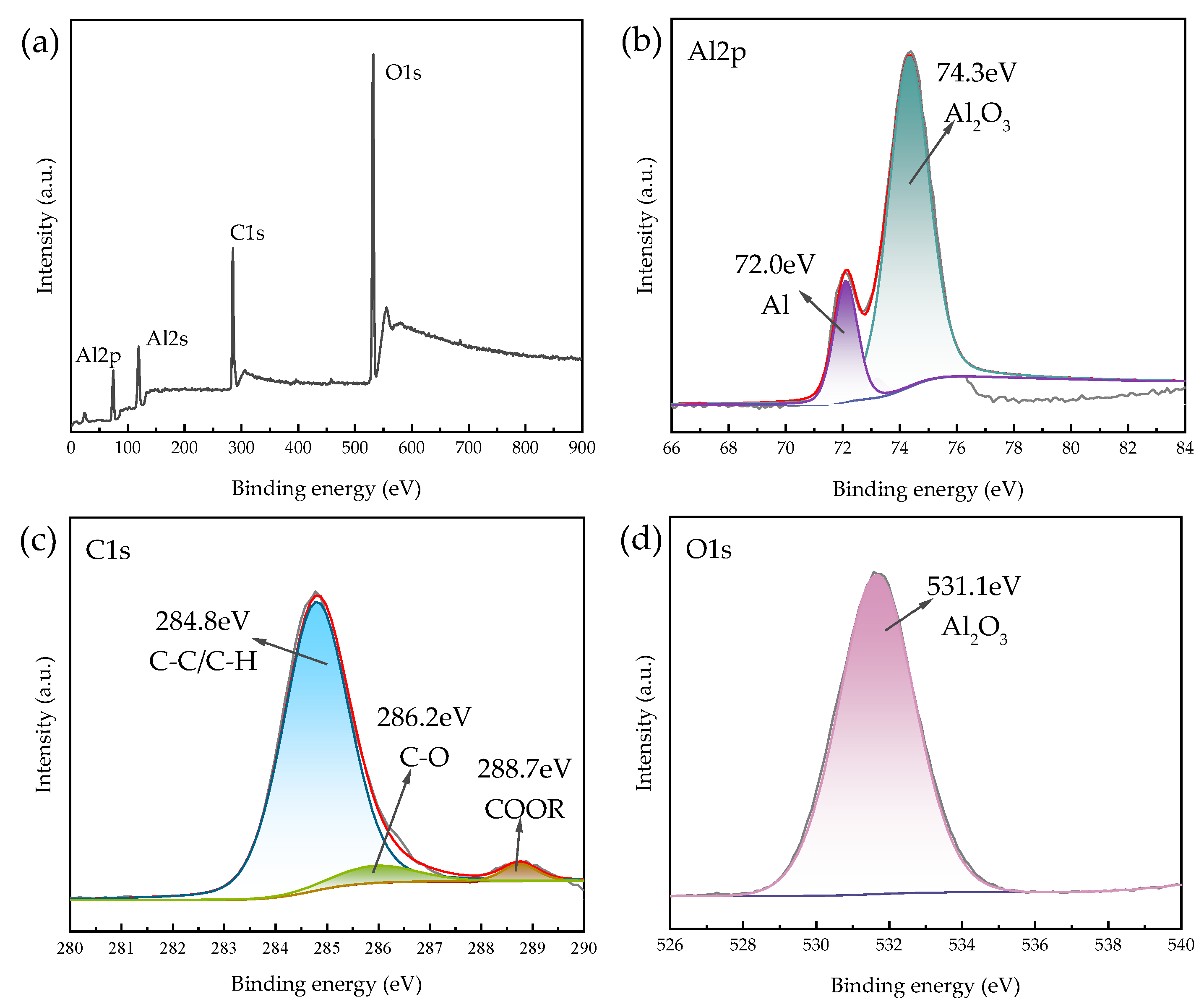Synthesis, Analysis, and Characterization of Aluminum Nanoparticles Coated with 2,2,4-Trimethylpentane
Abstract
:1. Introduction
2. Experiment
2.1. Materials
2.2. Fabrication of C8H18-Al Nanoparticles
3. Characterization and Performance
3.1. Equipment
3.2. Morphology Analysis
3.3. Particle Size Analysis
3.4. Active Aluminum Content Analysis
3.5. X-ray Electron Spectroscopy (XPS) Analysis
3.6. Thermal Analysis
- From 23 to 400 °C, the sample mass decreased by about 4.6%. Since amorphous alumina is hydrophilic [30], the increase in temperature leads to desorption of H2O and CO2 attached to the surface. At the same time, some of the amorphous carbon on the nanoparticle surface was oxidized into CO2 spillover [31]. The thickening of the amorphous oxide layer Al2O3 of the shell structure occurred at this stage.
- The sample mass gradually increased by about 27.4% from 400 to 693 °C. The exothermic peak at 593 °C on the DSC curve was the first oxidative exothermic peak, and the integration yielded an exotherm of 2.98 kJ/g. A phase change peak caused by the melting of unreacted aluminum appeared at 647.5 °C. The oxidation onset temperature on the TG curve was 554.2 °C, at which point the amorphous Al2O3 started to convert into γ-Al2O3. The subsequent flat weight gain was due to the alumina shell hindering the contact of aluminum with oxygen to reduce the probability of oxidation reaction. In addition, as the temperature increased, the molten aluminum destroyed the oxide layer, and the eruption of reactive aluminum caused the internal alumina nanoparticles to begin oxidization. Meanwhile, this phase of C8H18 was oxidized and decomposed to produce a series of olefins (C4H8, CH4, C2H2, and C3H6) [20].
- The temperature varied between 693 and 945 °C. The oxidation reaction of aluminum nanoparticles occurred predominantly at this stage [29], and the mass of the sample increased by 25.6%. The second exothermic peak on the DSC curve at 806.2 °C corresponded to the conversion of γ-Al2O3 to θ-Al2O3, which was calculated to be 2.72 kJ/g. The decomposition of C8H18 at this phase was basically complete [20].
- The temperature increased from 945 °C to the end of the ramp-up, by which time most of the Al nanoparticles were almost completely oxidized. The TG curve showed that there was still a mass change, which corresponded to a small exothermic peak at 1051.8 °C on the DSC curve, indicating that there was still an unreacted aluminum nanoparticle. After this point, the weight gain stopped, and θ-Al2O3 transformed into stably present α-Al2O3. The final C8H18-Al nanoparticles gained 67.3% in weight, with a total exothermic heat of 24.8 kJ/g.
3.7. Stability Performance
3.8. Energy Performance
4. Conclusions
Author Contributions
Funding
Institutional Review Board Statement
Informed Consent Statement
Data Availability Statement
Conflicts of Interest
References
- Subhan, A.; Mourad, A.-H.I.; Al-Douri, Y. Influence of Laser Process Parameters, Liquid Medium, and External Field on the Synthesis of Colloidal Metal Nanoparticles Using Pulsed Laser Ablation in Liquid: A Review. Nanomaterials 2022, 12, 2144. [Google Scholar] [CrossRef]
- Sundaram, D.S.; Yang, V.; Zarko, V.E. Combustion of Nano Aluminum Particles (Review). Combust. Explos. Shock. Waves 2015, 51, 173–196. [Google Scholar] [CrossRef]
- Zhang, S.; Bi, M.; Jiang, H.; Gao, W. Suppression Effect of Inert Gases on Aluminum Dust Explosion. Powder Technol. 2021, 388, 90–99. [Google Scholar] [CrossRef]
- Kim, K.T.; Kim, D.W.; Kim, S.H.; Kim, C.K.; Choi, Y.J. Synthesis and Improved Explosion Behaviors of Aluminum Powders Coated with Nano-Sized Nickel Film. Appl. Surf. Sci. 2017, 415, 104–108. [Google Scholar] [CrossRef]
- Wang, H.-X.; Ren, H.; Cui, Q.; Yan, T.; Li, Y.-R. Energy Release Prediction and Structure Characterization of Nano Aluminum Powder in Situ Coated by Polyethylene Glycol. Ferroelectrics 2020, 563, 161–176. [Google Scholar] [CrossRef]
- Cohen, O.; Michaels, D.; Yavor, Y. Agglomeration in Composite Propellants Containing Different Nano-Aluminum Powders. Propellants Explos. Pyrotech. 2022, 47, e202100320. [Google Scholar] [CrossRef]
- Yi, Q.; Xu, J.; Liu, Y.; Zhai, D.; Zhou, K.; Pan, D. Molecular Dynamics Study on Core-Shell Structure Stability of Aluminum Encapsulated by Nano-Carbon Materials. Chem. Phys. Lett. 2017, 669, 192–195. [Google Scholar] [CrossRef]
- Hong, S.; van Duin, A.C.T. Atomistic-Scale Analysis of Carbon Coating and Its Effect on the Oxidation of Aluminum Nanoparticles by ReaxFF-Molecular Dynamics Simulations. J. Phys. Chem. C 2016, 120, 9464–9474. [Google Scholar] [CrossRef]
- Kou, Y.; Wang, Y.; Zhang, J.; Guo, K.; Song, X. Iron/Aluminum Nanocomposites Prepared by One-Step Reduction Method and Their Effects on Thermal Decomposition of AP and AN. Def. Technol. 2021. [Google Scholar] [CrossRef]
- Ali, R.; Ali, F.; Zahoor, A.; Shahid, R.N.; Tariq, N.U.H.; Ali, G.; Ullah, S.; Shah, A.; Awais, H.B. Preparation and Oxidation of Aluminum Powders with Surface Alumina Replaced by Iron Coating. J. Energ. Mater. 2022, 40, 243–257. [Google Scholar] [CrossRef]
- Sung, M.-C.; Wang, Y.-F.; Chen, S.-C.; Tsai, C.-H. Two-Stage Plasma-Thermal Nitridation Processes for the Production of Aluminum Nitride Powders from Aluminum Powders. Materials 2019, 12, 359. [Google Scholar] [CrossRef] [PubMed]
- Kim, K.T.; Kim, D.W.; Kim, C.K.; Choi, Y.J. A Facile Synthesis and Efficient Thermal Oxidation of Polytetrafluoroethylene-Coated Aluminum Powders. Mater. Lett. 2016, 167, 262–265. [Google Scholar] [CrossRef]
- Liu, P.; Sui, P.; Feng, Z.; Gao, S.; Song, N.; Sun, R. Molecular Dynamic Investigations of Aluminum Nanoparticles Coated by the Mixtures of Ethanol and Diethyl Ether with Different Molecular Proportions. J. Nanoparticle Res. 2020, 22, 240. [Google Scholar] [CrossRef]
- Sun, R.; Liu, P.; Qi, H.; Liu, J.; Ding, T. Molecular Dynamic Simulations of Ether-Coated Aluminum Nano-Particles as a Novel Hydrogen Source. J. Nanopart. Res. 2019, 21, 72. [Google Scholar] [CrossRef]
- Ye, M.; Zhang, S.; Liu, S.; Han, A.; Chen, X. Preparation and Characterization of Pyrotechnics Binder–Coated Nano-Aluminum Composite Particles. J. Energ. Mater. 2017, 35, 300–313. [Google Scholar] [CrossRef]
- Wang, C.; Xu, J.; Dai, J.; Wang, Y.; Shen, Y.; Zhang, Z.; Shen, R.; Ye, Y. Probing the Reaction Mechanism of Al/CuO Nanocomposites Doped with Ammonium Perchlorate. Nanotechnology 2020, 31, 255401. [Google Scholar] [CrossRef]
- Zhang, L.; Wang, S.; Su, X.; Li, X.; Zou, M. Preparation and Characterization of Core-Shell Al@PFHP with Improving the Combustion and Ignition Properties of Aluminum Powder. Particuology 2023, 77, 62–70. [Google Scholar] [CrossRef]
- Li, N.; Zhang, Y.; Guo, R.; Yang, J.; Zhang, X.; Wang, X. Effect of Stearic Acid Coating on the Explosion Characteristics of Aluminum Dust. Fuel 2022, 320, 123880. [Google Scholar] [CrossRef]
- Westrich, T.A.; Chen, X.; Schwank, J.W. Isooctane Decomposition and Carbon Deposition over Ceria–Zirconia Supported Nickel Catalysts. Appl. Catal. Gen. 2010, 386, 83–93. [Google Scholar] [CrossRef]
- Guan, Y.; Gao, Y.; Lou, J.; Zhu, X.; Pan, D.; Ma, H. High-Temperature Thermal Decomposition of Iso-Octane Based on Reactive Molecular Dynamics Simulations. J. Mol. Model. 2022, 28, 124. [Google Scholar] [CrossRef] [PubMed]
- Ogawa, F.; Masuda, C. Interface Observation of Aluminum-Coated Carbon Nanofibers Prepared by in Situ Chemical Vapor Deposition. J. Phys. Chem. C 2017, 121, 6126–6132. [Google Scholar] [CrossRef]
- Xiao, F.; Gao, W.; Li, J.; Yang, R. Effect of the Aluminum Particle Size, Solid Content, and Aluminum/Oxygen Ratio on the Underwater Explosion Performance of Aluminum-Based Explosives. Combust. Explos. Shock Waves 2020, 56, 576–584. [Google Scholar] [CrossRef]
- National Development and Reform Commission of the People’s Republic of China. Determination of Chemical Compositions and Physical Properties of Aluminum Powder, Magnesium Powder and Al-Mg Alloy Powder—Part 1: Determination of Active Al, Mg or Al-Mg Content—Gasometric Method; National Development and Reform Commission of the People’s Republic of China: Beijing, China, 2007; Volume YS/T 617.1-2007, pp. 1–3.
- Wang, H.; Ren, H.; Yan, T.; Li, Y. Micro-structure and Active Aluminum Content of Aluminum Powder in Situ Coated by Polyvinyl Alcohol. Acta Armamentarii 2019, 40, 1373–1380. [Google Scholar]
- Gall, S.; Manuel, S.; Lerat, J.-F. Boron Laser Doping through High Quality Al2O3 Passivation Layer for Localized B-BSF PERL Solar Cells. Energy Procedia 2013, 38, 270–277. [Google Scholar] [CrossRef]
- McMahon, B.W.; Perez, J.P.L.; Yu, J.; Boatz, J.A.; Anderson, S.L. Anderson Synthesis of Nanoparticles from Malleable and Ductile Metals Using Powder-Free, Reactant-Assisted Mechanical Attrition. ACS Appl. Mater. Interfaces 2014, 6, 19579–19591. [Google Scholar] [CrossRef]
- Song, Y.; Zhen, W.; Han, W.; Zhou, Y.; Sun, J. Polymethylmethacrylate Grafting onto Polyvinyl Alcohol/Modified Feldspar Composites: Preparation, Properties and Structure Characterization. Iran. Polym. J. 2014, 23, 375–386. [Google Scholar] [CrossRef]
- Saceleanu, F.; Atashin, S.; Wen, J.Z. Investigation of the Effects of Phase Transformations in Micro and Nano Aluminum Powders on Kinetics of Oxidation Using Thermogravimetric Analysis. Phys. Chem. Chem. Phys. 2017, 19, 18996–19009. [Google Scholar] [CrossRef] [PubMed]
- Noor, F.; Zhang, H.; Korakianitis, T.; Wen, D. Oxidation and Ignition of Aluminum Nanomaterials. Phys. Chem. Chem. Phys. 2013, 15, 20176–20188. [Google Scholar] [CrossRef]
- Abdelkader, E.M.; Jelliss, P.A.; Buckner, S.W. Main Group Nanoparticle Synthesis Using Electrical Explosion of Wires. Nano-Struct. Nano-Objects 2016, 7, 23–31. [Google Scholar] [CrossRef]
- Cheng, Y.Z.; Ren, H.; Li, Y.-R.; Jiao, Q.-J. Fluorine-coated High Reactive Al with Modified Metal Electric Explosion Wire Method. Chin. J. Explos. Propellants 2021, 44, 753–760. [Google Scholar]
- Commission for Science, Technology and Industry for National Defense. Test Method of Loading Material for Initiating Explosive Device—Part 13: Heat Endurance Test—Method of 75 °C Heat; Commission for Science, Technology and Industry for National Defense: Beijing, China, 2006; Volume GJB 5891.13-2006. [Google Scholar]
- Commission for Science, Technology and Industry for National Defense. Explosive Test Method; Commission for Science, Technology and Industry for National Defense: Beijing, China, 1997; Volume GJB 772A-97. [Google Scholar]
- Commission for Science, Technology and Industry for National Defense. Test Method of Propellant; Commission for Science, Technology and Industry for National Defense: Beijing, China, 2005; Volume GJB 770B-2005, pp. 304–312. [Google Scholar]






| Sample | Active Al Content (%) |
|---|---|
| C8H18-Al | 85.45 |
| Ordinary nano Al [25] | 59.18 |
| Micro Al [25] | 90.73 |
| Sample | Onset Temperature (°C) | Weight Gain (∆m %) |
|---|---|---|
| C8H18-Al | 554.2 | 67.3 |
| Ordinary nano Al [25] | 567.0 | 57.0 |
| Micro Al [25,32] | 555.7 | 81.0 |
Disclaimer/Publisher’s Note: The statements, opinions and data contained in all publications are solely those of the individual author(s) and contributor(s) and not of MDPI and/or the editor(s). MDPI and/or the editor(s) disclaim responsibility for any injury to people or property resulting from any ideas, methods, instructions or products referred to in the content. |
© 2023 by the authors. Licensee MDPI, Basel, Switzerland. This article is an open access article distributed under the terms and conditions of the Creative Commons Attribution (CC BY) license (https://creativecommons.org/licenses/by/4.0/).
Share and Cite
Wang, G.; Wang, H.; Cui, Q.; Li, X.; Wu, X.; Liao, H.; Zhang, Z. Synthesis, Analysis, and Characterization of Aluminum Nanoparticles Coated with 2,2,4-Trimethylpentane. Metals 2023, 13, 322. https://doi.org/10.3390/met13020322
Wang G, Wang H, Cui Q, Li X, Wu X, Liao H, Zhang Z. Synthesis, Analysis, and Characterization of Aluminum Nanoparticles Coated with 2,2,4-Trimethylpentane. Metals. 2023; 13(2):322. https://doi.org/10.3390/met13020322
Chicago/Turabian StyleWang, Guanyi, Huixin Wang, Qingzhong Cui, Xiaoping Li, Xingyu Wu, Hongzhe Liao, and Zhe Zhang. 2023. "Synthesis, Analysis, and Characterization of Aluminum Nanoparticles Coated with 2,2,4-Trimethylpentane" Metals 13, no. 2: 322. https://doi.org/10.3390/met13020322
APA StyleWang, G., Wang, H., Cui, Q., Li, X., Wu, X., Liao, H., & Zhang, Z. (2023). Synthesis, Analysis, and Characterization of Aluminum Nanoparticles Coated with 2,2,4-Trimethylpentane. Metals, 13(2), 322. https://doi.org/10.3390/met13020322






